The ash tree is headed for widespread extinction across the United States in the wake of the invasive and unstoppable emerald ash borers. The New Jersey Department of Agriculture notes that “Trees will only live an average of 3-4 years after infestation and 99% of ash trees will die.” This is compared to the average lifespan of a healthy ash tree which is anywhere between 60-75 years. Currently 24% of New Jersey forests have ash trees, typically green ash and white ash. This means 24.7 million ash trees in the state are at strong risk of death. Emerald ash borers are at the center of this epidemic with the intense, destructive behaviors sweeping New Jersey and Pennsylvania.
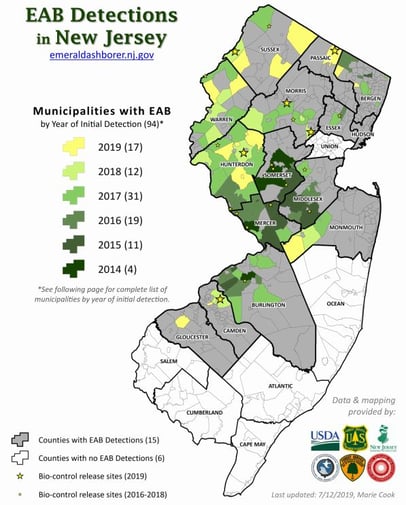
Emerald ash borers (EAB) are shiny emerald in color. Adult bodies are 3/8 – 1/2 inch long and 1/16 inch wide. Surprisingly, adults cause little damage to ash trees other than chewing on their leaves. The most destructive phase in the lifecycle is the nearly invisible one: larvae. Emerald ash borer eggs are laid beneath the surface of ash tree bark, chewing galleries through the tree and causing irreversible damage. The larval state lasts 1-2 years before they emerge through signature D-shaped holes to mate. This means at least one year of damage occurs beneath the surface of the tree’s bark.
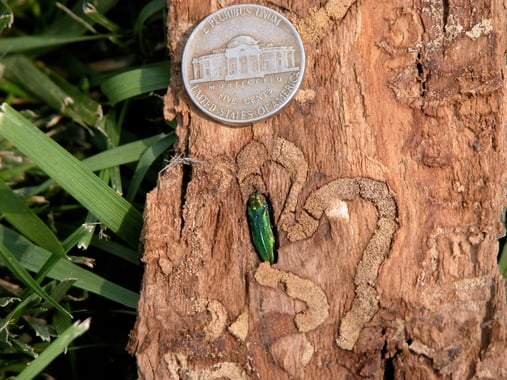
Photo Credit: Virginia Tech Department of Forestry
Are they dangerous?
Emerald ash borers do not breed or overwinter in humanmade structures such as residential homes and commercial office buildings. They do not bite, sting, or transmit diseases that impact human and pet health. Keeping ash trees alive means saving a natural producer of oxygen into our environment as well as maintaining the aesthetic of your property and neighborhood. Because ash trees are common in residential neighborhoods in New Jersey and Pennsylvania, an invasion can become widespread very quickly.
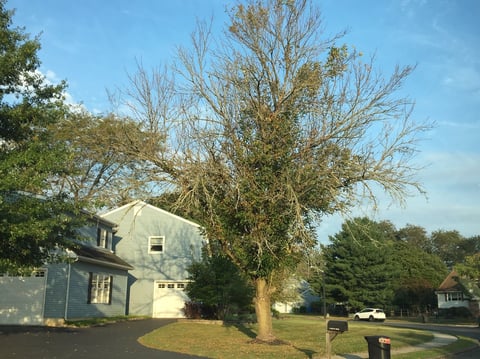
Pictured Above: Ash trees are dying in Hamilton Square, NJ
One of our employees counted at least ten distressed trees in his Hamilton Square neighborhood near Sayen Gardens, one of which is shown above, taken on September 23rd, 2019. While plenty of ash trees have already been removed from the same neighborhood over the past 12 months, there are still many more distressed trees that unfortunately will not survive.
Ash Tree Identification
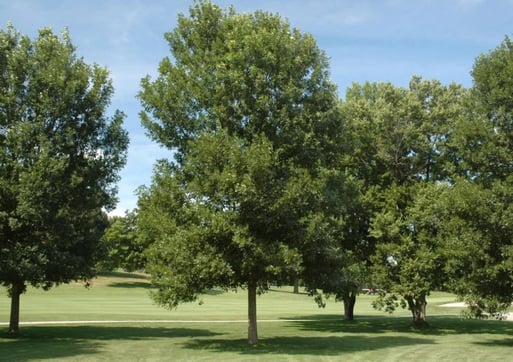
Pictured Above: a healthy ash tree Photo Credit: The New York Post
White ash (most common in NJ and PA) trees can grow up to 120 feet tall and 40-50 feet wide. The leaves of a healthy ash tree are green in the spring, and yellow, orange, and red in the fall. Their leaves are composed of 5-11 leaflets which are directly across from one another. The bark of an ash tree has a very distinct pattern with hard vertical ridges. Ash trees are not only beneficial to the environment, but their wood is commonly used for the production of baseball bats, hockey sticks, guitars, drums, canoe paddles, and more. Their firewood is used for smoking meats and other food.
Signs Emerald Ash Borers Are Taking Over Your Trees
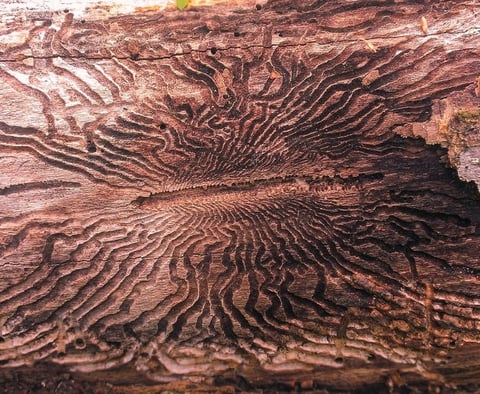
Pictured Above: Galleries created by emerald ash borer larvae under the bark of an ash tree
The damage that emerald ash borers cause is extremely detrimental to the health of your trees. If you suspect that your ash trees are suffering as a result of this pest’s activity, look out for the tops signs of emerald ash borer damage.
- Galleries- Larvae live below the bark of ash trees while they develop and overwinter during the cold moths, beginning now in September. They create zig zag patterns that grow larger in width as the pest grows in size.
- Exit holes- After reaching adulthood, emerald ash borers leave the ash tree by chewing through the bark, leaving a signature 1/8th inch D-shaped exit hole. Several exit holes will exist in a single tree at any given time.
- Thinning tree crowns- Ash trees thin out and lose leaves beginning at the top (the crown) of the tree, working its way down.
- Damaged leaves- When a tree is being affected by emerald ash borer activity, they feed on leaves in a notch-like fashion. Leaves appear ragged and uneven on the sides.
- Woodpecker activity- Emerald ash borer larvae are a food source for local woodpeckers. Their presence both indicates possible emerald ash borer infestations and a positive sign for natural pest control.
Should I cut down my ash tree?
The New Jersey Department of Agriculture indicates the following steps to address emerald ash borer infestations.
- Any trees determined to be a high safety risk should be removed immediately.
- Any actively infested trees should be cut down and chipped as soon as possible and then left on site (in the municipality).
- For all other ash, it is best to complete removals in the fall and winter. The material must be processed (chipped or de-barked) before emergence (by late April).
- For municipalities, we recommend triage of the ash resource to spread out ash removals over several years.
- Utilize ash wood as completely and as locally as possible. Municipalities can recycle ash for use as firewood or wood chips.
- In the landscape (trees planted in yards near homes, along municipal streets, and in parks, playgrounds, campgrounds, etc.), “do nothing” is not an option, as over 99% of untreated ash trees in the landscape will eventually become infested and die from EAB.
- In wooded areas, the decision to “do nothing” is an option, but should be a conscious decision with the understanding that the ash trees will eventually become infested, die, and fall. This should only be done in secluded areas where there is no/minimal risk associated with these trees when they die, and where there is limited funding and staff for other options.
Although chemical treatments are available, at this point, there is not much we can do to save dying ash trees. According to the Entomological Society of America, “If the tree has lost more than 50 percent of its canopy due to EAB infestation, treatments are unlikely to save the tree.”
To learn more about emerald ash borers, visit your local state-level Department of Agriculture’s website by clicking the links below.
New Jersey Department of Agriculture
Pennsylvania Department of Agriculture
As the leading pest control company in NJ and PA, this update is for informational purposes since Cooper Pest Solutions does not provide pest control services for emerald ash borers.

